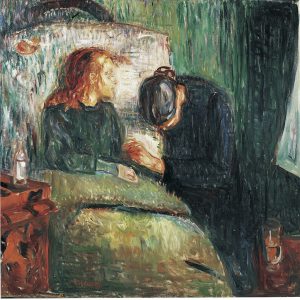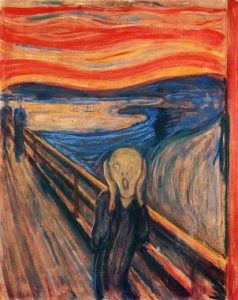Edvard Munch was a Norwegian painter, whose best-known work, The Scream, has become one of the most iconic images of world art.

Image source:https://commons.wikimedia.org/wiki/File:Edvard_Munch_-_Anxiety_-_Google_Art_Project.jpg
Edvard Munch was born in Norway and was an expressionist painter, and typographer. He played an important role in the late 20th century in German Expressionism, and the art form that followed; due to the strong mental anguish shown in many of his pieces.
Early life and education
Edvard Munch was born in 1863 on a rustic farm in the village of Adalsbruk, located in Loten, Norway. Illness, bereavement, and the fear of inheriting a mental condition present in the family characterized his childhood. Studying at the Royal School of Art and Design in Kristiania (now Oslo), Munch began living a bohemian life under the influence of the nihilist Hans Jæger, who prompted him to paint his own emotional and psychological state (‘soul painting’), thus bringing out his distinctive style.

Image source: https://commons.wikimedia.org/wiki/File:Edvard_Munch_im_Lindeschen_Garten,_L%C3%BCbeck_1902.jpg
The journey brought him new influences and new outlets. In Berlin, he met Swedish playwright August Strindberg, who painted, as he embarked on his main canon The Frieze of Life, depicting several deeply-felt themes such as love, jealousy, anxiety, and betrayal, imbued in the atmosphere.
The age of Freud and psychoanalysis

Image source: https://search.creativecommons.org/photos/1d56dc8c-7dbb-433a-a0b7-52ebd5311464
Considering that Munch was of a generation with Sigmund Freud and the first rumblings of psychoanalysis and that he too understood the power of subjective experience and the irrational forces of the mind, a more developed picture shows Munch as a diagnostician of the internal human condition who was well-educated on the artistic and intellectual trends of his time.
Munch’s early work, for example, was lighter in tone than his mature work and was largely influenced by the French Impressionists of the 1870s and 1880s. Though he would move on to darker subjects in the latter half of the 1880s, he was extremely prolific and continued painting bright landscapes and milder portraits of family members and friends throughout his career.
Studies on human condition
When Munch began painting darker subjects like The Sick Child—part of a series that began in 1885 that he would rework into the 1920s—he was responding to the psychic turmoil of growing up in a home destroyed by illness, while also trying to channel the introspective aspects of the Symbolist movement, which became a kind of troubled Romanticism towards the end of the 19th century.

Image source:https://commons.wikimedia.org/wiki/File:Edvard_Munch_-_The_sick_child_(1907)_-_Tate_Modern.jpg
Like many of Munch’s most powerful works, The Sick Child is a painting about various psychological states. If the sick child (modeled after Munch’s consumptive sister) conveys the inevitability of death, then the faceless keeper, who bows her head and refuses to meet the convalescent’s gaze, takes our place as a helpless spectator who represses the idea of mortality.
The scream

Image source: https://search.creativecommons.org/photos/5d536514-896e-4dc6-aab5-feb39d2fb824
Edvard Munch painted this work after a walk on Ekeberg hill, above Oslo. Looking at the sunset, the artist was overwhelmed by a melancholy that became fear when the sky turned red like blood.
Looking at that sky he heard a scream that pierced nature.
Munch’s Scream is the representation of a feeling of fear and the artist transmits it to the viewer through colors and a composition that represents an absolute novelty in the world of art. The protagonist is placed in a landscape built with wavy lines and which seems to be unreal. It’s a moodscape, a free interpretation of the artist based on what he felt at that moment.
The man himself, in the foreground, is caught screaming at the top of his lungs and raising his hands to cover his ears, and all the elements of the painting become an extension of the artist’s feelings. The wavy lines are like a labyrinth of emotions and the viewer’s eye, wandering in all directions in search of a reference point, produces a feeling of confusion.
Info sources: https://www.artsy.net/ https://www.theartstory.org/artist/munch-edvard/ https://en.wikipedia.org/wiki/Edvard_Munch https://www.edvardmunch.org/ https://www.theartpostblog.com/en/scream-munch/
